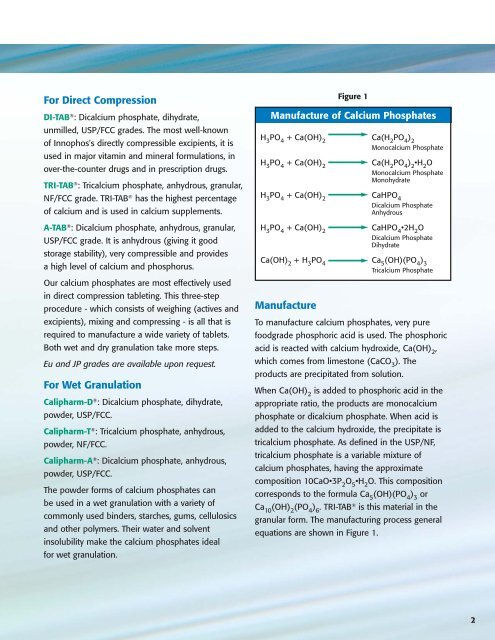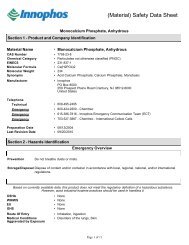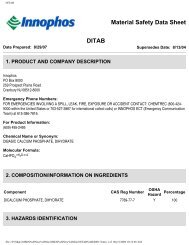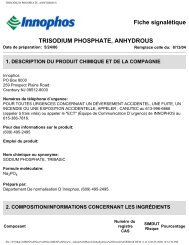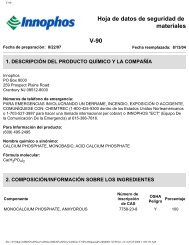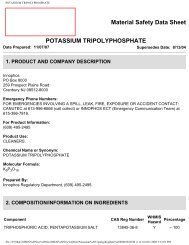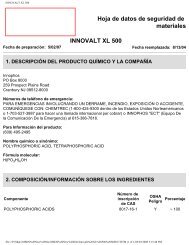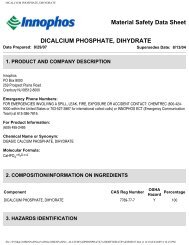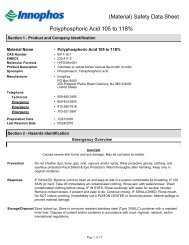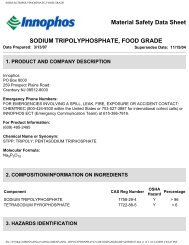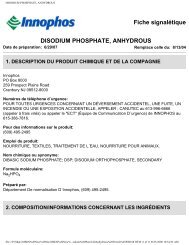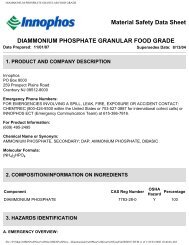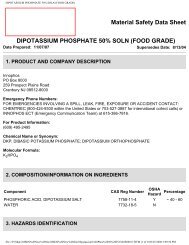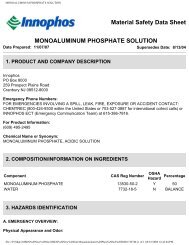Calcium Phosphate Excipients - Innophos
Calcium Phosphate Excipients - Innophos
Calcium Phosphate Excipients - Innophos
Create successful ePaper yourself
Turn your PDF publications into a flip-book with our unique Google optimized e-Paper software.
For Direct Compression<br />
DI-TAB ® : Dicalcium phosphate, dihydrate,<br />
unmilled, USP/FCC grades. The most well-known<br />
of <strong>Innophos</strong>'s directly compressible excipients, it is<br />
used in major vitamin and mineral formulations, in<br />
over-the-counter drugs and in prescription drugs.<br />
TRI-TAB ® : Tricalcium phosphate, anhydrous, granular,<br />
NF/FCC grade. TRI-TAB ® has the highest percentage<br />
of calcium and is used in calcium supplements.<br />
A-TAB ® : Dicalcium phosphate, anhydrous, granular,<br />
USP/FCC grade. It is anhydrous (giving it good<br />
storage stability), very compressible and provides<br />
a high level of calcium and phosphorus.<br />
Our calcium phosphates are most effectively used<br />
in direct compression tableting. This three-step<br />
procedure - which consists of weighing (actives and<br />
excipients), mixing and compressing - is all that is<br />
required to manufacture a wide variety of tablets.<br />
Both wet and dry granulation take more steps.<br />
Eu and JP grades are available upon request.<br />
For Wet Granulation<br />
Calipharm-D ® : Dicalcium phosphate, dihydrate,<br />
powder, USP/FCC.<br />
Calipharm-T ® : Tricalcium phosphate, anhydrous,<br />
powder, NF/FCC.<br />
Calipharm-A ® : Dicalcium phosphate, anhydrous,<br />
powder, USP/FCC.<br />
The powder forms of calcium phosphates can<br />
be used in a wet granulation with a variety of<br />
commonly used binders, starches, gums, cellulosics<br />
and other polymers. Their water and solvent<br />
insolubility make the calcium phosphates ideal<br />
for wet granulation.<br />
Manufacture of <strong>Calcium</strong> <strong>Phosphate</strong>s<br />
H 3<br />
PO 4<br />
+ Ca(OH) 2<br />
Ca(H 2<br />
PO 4<br />
) 2<br />
Monocalcium <strong>Phosphate</strong><br />
H 3<br />
PO 4<br />
+ Ca(OH) 2<br />
Manufacture<br />
Ca(H 2<br />
PO 4<br />
) 2<br />
•H 2<br />
O<br />
Monocalcium <strong>Phosphate</strong><br />
Monohydrate<br />
H 3<br />
PO 4<br />
+ Ca(OH) 2<br />
CaHPO 4<br />
Dicalcium <strong>Phosphate</strong><br />
Anhydrous<br />
H 3<br />
PO 4<br />
+ Ca(OH) 2<br />
Figure 1<br />
CaHPO 4<br />
•2H 2<br />
O<br />
Dicalcium <strong>Phosphate</strong><br />
Dihydrate<br />
Ca(OH) 2<br />
+ H 3<br />
PO 4<br />
Ca 5<br />
(OH)(PO 4<br />
) 3<br />
Tricalcium <strong>Phosphate</strong><br />
To manufacture calcium phosphates, very pure<br />
foodgrade phosphoric acid is used. The phosphoric<br />
acid is reacted with calcium hydroxide, Ca(OH) 2<br />
,<br />
which comes from limestone (CaCO 3<br />
). The<br />
products are precipitated from solution.<br />
When Ca(OH) 2<br />
is added to phosphoric acid in the<br />
appropriate ratio, the products are monocalcium<br />
phosphate or dicalcium phosphate. When acid is<br />
added to the calcium hydroxide, the precipitate is<br />
tricalcium phosphate. As defined in the USP/NF,<br />
tricalcium phosphate is a variable mixture of<br />
calcium phosphates, having the approximate<br />
composition 10CaO•3P 2<br />
O 5<br />
•H 2<br />
O. This composition<br />
corresponds to the formula Ca 5<br />
(OH)(PO 4<br />
) 3<br />
or<br />
Ca 10<br />
(OH) 2<br />
(PO 4<br />
) 6<br />
. TRI-TAB ® is this material in the<br />
granular form. The manufacturing process general<br />
equations are shown in Figure 1.<br />
2


